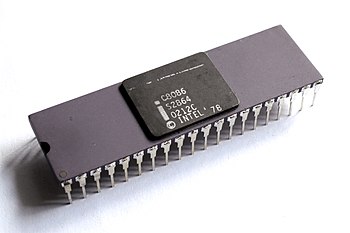Intel 8086: Difference between revisions
Jump to navigation
Jump to search

Pat Palmer (talk | contribs) (correcting link to CPU) |
Pat Palmer (talk | contribs) mNo edit summary |
||
| (One intermediate revision by one other user not shown) | |||
| Line 1: | Line 1: | ||
{{subpages}} | {{subpages}} | ||
The | {{Image|Intel C8086.jpg|right|350px|An Intel 8086 chip.}} | ||
The '''Intel 8086''', and the closely related 8088, were early [[Central processing unit|CPU]]s, from [[Intel]]. The 8088 was the CPU that powered the original [[IBM PC]]. | |||
The 8086 and the 8088 executed identical instruction sets, but differed in the size of their data bus. | The 8086 and the 8088 executed identical instruction sets, but differed in the size of their data bus. The 8088 was slower, since it only had an 8-bit data bus, while the 8086 had a 16-bit data bus. This meant operations on 16-bit numbers would always require an extra clock cycle. | ||
Both CPUs could address 1 megabyte of memory, in contrast to | Both CPUs could address 1 megabyte of memory, in contrast to Intel's earlier 8080, which could only address 64 kilobytes of memory. | ||
Latest revision as of 10:17, 12 July 2023
The Intel 8086, and the closely related 8088, were early CPUs, from Intel. The 8088 was the CPU that powered the original IBM PC.
The 8086 and the 8088 executed identical instruction sets, but differed in the size of their data bus. The 8088 was slower, since it only had an 8-bit data bus, while the 8086 had a 16-bit data bus. This meant operations on 16-bit numbers would always require an extra clock cycle.
Both CPUs could address 1 megabyte of memory, in contrast to Intel's earlier 8080, which could only address 64 kilobytes of memory.
